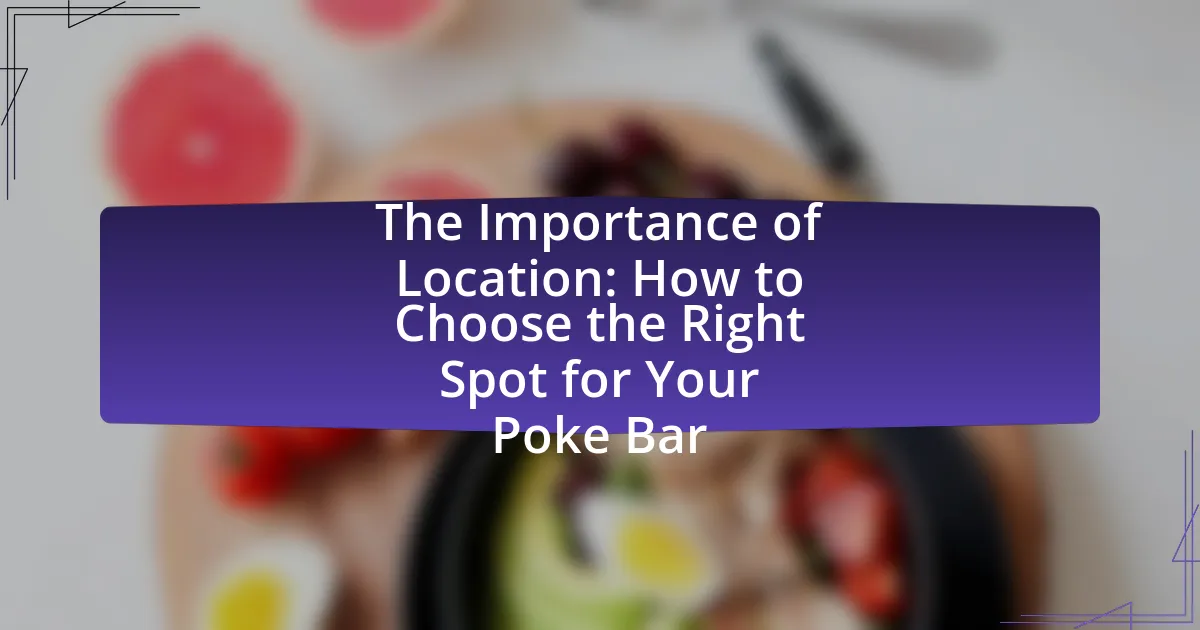The article focuses on the critical role of location in the success of a poke bar, emphasizing factors such as foot traffic, target demographics, competition, and accessibility. It highlights how high-traffic areas, particularly near universities or shopping districts, can significantly boost customer patronage and sales. Additionally, the article discusses the importance of understanding local demographics and cultural preferences, as well as the impact of zoning laws and regulations on location selection. Key considerations for evaluating potential sites include logistical aspects, customer profiles, and the use of market research and location analytics to inform decisions.

Why is Location Important for a Poke Bar?
Location is crucial for a poke bar because it directly influences customer foot traffic and accessibility. A prime location in a high-traffic area, such as near universities or busy shopping districts, increases visibility and attracts more customers. Studies show that restaurants located in densely populated areas experience higher sales, with a 2019 report indicating that establishments in urban centers can see up to 30% more patronage compared to those in suburban locations. Additionally, proximity to complementary businesses, like gyms or health food stores, can enhance customer flow, as individuals seeking healthy dining options are more likely to visit a poke bar after their workouts or shopping trips.
What factors influence the choice of location for a Poke Bar?
The choice of location for a Poke Bar is influenced by factors such as foot traffic, target demographic, competition, and accessibility. High foot traffic areas, like shopping districts or near universities, attract more customers, while understanding the target demographic ensures the menu and pricing align with local preferences. Analyzing competition helps identify market saturation and potential differentiation strategies. Additionally, accessibility, including parking availability and public transport options, affects customer convenience and overall sales potential.
How does foot traffic impact the success of a Poke Bar?
Foot traffic significantly impacts the success of a Poke Bar by directly influencing customer volume and sales. High foot traffic areas, such as busy streets or shopping districts, increase visibility and attract more potential customers, leading to higher sales opportunities. According to a study by the International Council of Shopping Centers, retail locations with high foot traffic can see sales increases of up to 30% compared to those in lower traffic areas. This correlation between foot traffic and sales underscores the importance of selecting a location that maximizes exposure to potential patrons.
What role does competition play in selecting a location?
Competition significantly influences the selection of a location for a poke bar. A high level of competition can indicate a strong market demand, suggesting that the area is popular among consumers for dining options. For instance, research shows that locations with multiple successful restaurants often attract more foot traffic, which can benefit new entrants. Additionally, understanding competitors’ strengths and weaknesses allows a poke bar to differentiate its offerings, enhancing its appeal to potential customers. Therefore, analyzing the competitive landscape is crucial for making informed decisions about location selection.
How does the demographic of an area affect Poke Bar location choices?
The demographic of an area significantly influences Poke Bar location choices by determining the target customer base and their preferences. Areas with a higher concentration of health-conscious individuals, such as urban centers or college towns, are more likely to support a Poke Bar due to the popularity of fresh, nutritious food options. For instance, according to a report by IBISWorld, the fast-casual dining segment, which includes Poke Bars, has seen growth in regions with younger populations who prioritize healthy eating. Additionally, income levels and cultural diversity in an area can affect menu offerings and marketing strategies, as higher disposable incomes may allow for premium pricing and diverse flavor profiles that cater to various ethnic backgrounds.
What customer profiles should be considered when choosing a location?
When choosing a location for a poke bar, customer profiles to consider include health-conscious individuals, millennials, families, and local food enthusiasts. Health-conscious individuals prioritize fresh, nutritious options, making them likely to frequent poke bars that emphasize quality ingredients. Millennials often seek trendy dining experiences and are drawn to unique food offerings, which can drive foot traffic to a well-located poke bar. Families typically look for convenient dining options that cater to diverse tastes, making locations near residential areas or family-friendly attractions ideal. Local food enthusiasts appreciate establishments that source ingredients locally, enhancing community engagement and loyalty. These profiles are supported by market research indicating that 70% of millennials prefer dining at restaurants that offer healthy options, while family dining accounts for a significant portion of restaurant sales, highlighting the importance of understanding customer demographics in location selection.
How can local culture influence the appeal of a Poke Bar?
Local culture significantly influences the appeal of a Poke Bar by shaping menu offerings, decor, and marketing strategies. For instance, in areas with a strong emphasis on health and wellness, a Poke Bar may attract customers by highlighting fresh, organic ingredients and customizable options that align with local dietary preferences. Additionally, cultural events and community engagement can enhance visibility and foster a loyal customer base. Research indicates that restaurants that adapt to local tastes and preferences see a 20% increase in customer satisfaction, demonstrating the importance of cultural alignment in the food industry.

What are the Key Considerations for Choosing a Location?
Key considerations for choosing a location for a poke bar include foot traffic, competition, target demographic, and accessibility. High foot traffic areas, such as shopping districts or near universities, increase visibility and customer potential. Analyzing competition helps identify market saturation and unique selling propositions. Understanding the target demographic ensures that the menu and pricing align with local preferences. Accessibility, including parking and public transport options, influences customer convenience and overall patronage. These factors collectively contribute to the success of a poke bar in attracting and retaining customers.
How do zoning laws and regulations affect Poke Bar locations?
Zoning laws and regulations significantly impact Poke Bar locations by dictating where such establishments can operate based on land use classifications. These laws determine whether a Poke Bar can be situated in commercial, residential, or mixed-use zones, influencing accessibility and customer demographics. For instance, a Poke Bar located in a commercial zone is more likely to attract foot traffic and customers compared to one in a strictly residential area, where such businesses may be prohibited. Additionally, zoning regulations may impose restrictions on signage, parking requirements, and operational hours, further affecting the viability and attractiveness of the location for potential customers.
What permits are necessary for operating a Poke Bar in different areas?
To operate a Poke Bar, various permits are necessary, which can differ by location. Typically, a food service establishment permit is required, along with a health department permit to ensure compliance with food safety regulations. Additionally, a business license is essential for legal operation, and a signage permit may be needed if the establishment plans to display outdoor signage. Local zoning laws may also dictate specific permits based on the area’s regulations regarding food service businesses. These requirements are enforced to maintain public health standards and ensure that the business operates within legal frameworks.
How can zoning restrictions limit location options?
Zoning restrictions can limit location options by designating specific areas for particular types of land use, thereby restricting where businesses like poke bars can operate. For instance, if a zoning ordinance classifies an area as residential, it may prohibit commercial establishments, forcing business owners to seek locations in designated commercial zones. According to the American Planning Association, these regulations can significantly impact the availability of suitable sites, as they dictate the types of activities permitted in various districts, ultimately narrowing the choices for entrepreneurs looking to establish their poke bars.
What are the logistical aspects to consider when selecting a location?
When selecting a location for a poke bar, key logistical aspects include accessibility, foot traffic, parking availability, and proximity to suppliers. Accessibility ensures that customers can easily reach the poke bar, while high foot traffic increases visibility and potential sales. Adequate parking is crucial for customer convenience, especially in urban areas. Proximity to suppliers affects inventory management and delivery efficiency, impacting overall operational costs. These factors collectively influence the success and sustainability of the poke bar.
How does accessibility impact customer visits to a Poke Bar?
Accessibility significantly impacts customer visits to a Poke Bar by determining how easily potential customers can reach the location. High accessibility, such as proximity to public transportation, ample parking, and pedestrian-friendly pathways, increases foot traffic and attracts more customers. For instance, a study by the American Planning Association found that businesses located near public transit hubs experience a 20-30% increase in customer visits compared to those that are not easily accessible. Therefore, ensuring that a Poke Bar is situated in an area with high accessibility can lead to higher customer engagement and sales.
What are the implications of parking availability for a Poke Bar?
Parking availability significantly impacts customer access and convenience for a Poke Bar. Limited parking can deter potential customers, leading to decreased foot traffic and lower sales. Research indicates that 67% of consumers consider parking availability when choosing a dining location, highlighting its critical role in attracting patrons. Additionally, a Poke Bar situated in an area with ample parking is more likely to benefit from higher customer retention and satisfaction, as easy access encourages repeat visits.

How Can You Evaluate Potential Locations for Your Poke Bar?
To evaluate potential locations for your poke bar, conduct a thorough analysis of foot traffic, demographics, competition, and accessibility. Foot traffic is crucial; high pedestrian volume increases visibility and customer potential. Research shows that locations with over 10,000 daily foot traffic can significantly boost sales for food establishments. Demographics matter as well; target areas with a population that enjoys healthy eating, typically younger adults and health-conscious individuals. Analyze competition by identifying nearby restaurants and their offerings; a saturated market may indicate a need for differentiation. Lastly, assess accessibility, ensuring the location is easy to reach by car or public transport, as studies indicate that convenience directly influences dining choices.
What tools and methods can be used to assess location viability?
To assess location viability, tools and methods such as Geographic Information Systems (GIS), market analysis, demographic studies, and site visits can be utilized. GIS allows for spatial analysis of location data, helping to visualize factors like competition and customer demographics. Market analysis provides insights into local demand and consumer behavior, while demographic studies offer detailed information on population characteristics, income levels, and lifestyle preferences. Site visits enable firsthand evaluation of the physical environment and accessibility. These methods collectively ensure a comprehensive understanding of a location’s potential for success in the context of a poke bar.
How can market research inform location decisions for a Poke Bar?
Market research can inform location decisions for a Poke Bar by identifying target demographics, analyzing competitor presence, and assessing foot traffic patterns. By understanding the preferences and behaviors of potential customers, market research reveals areas with high demand for Poke offerings, such as regions with a significant population of health-conscious individuals or sushi enthusiasts. Additionally, analyzing competitors helps to determine optimal locations that either capitalize on existing demand or fill gaps in the market. For instance, a study by IBISWorld indicates that the fast-casual dining sector, which includes Poke Bars, thrives in urban areas with high pedestrian traffic, suggesting that locations near offices, universities, or busy shopping districts are advantageous. Thus, leveraging market research enables informed decisions that align with consumer trends and competitive dynamics, ultimately enhancing the likelihood of success for a Poke Bar.
What role do location analytics play in evaluating potential sites?
Location analytics play a crucial role in evaluating potential sites by providing data-driven insights that inform decision-making. These analytics utilize geographic information systems (GIS) to analyze demographic data, consumer behavior, and market trends, enabling businesses to identify optimal locations based on factors such as foot traffic, competition, and accessibility. For instance, a study by Esri found that businesses leveraging location analytics can increase sales by up to 20% by selecting sites that align with target customer demographics and preferences. This evidence underscores the effectiveness of location analytics in enhancing site selection processes for businesses like poke bars.
What are the best practices for conducting a location analysis?
The best practices for conducting a location analysis include assessing demographic data, analyzing competition, evaluating accessibility, and considering local regulations. Demographic data provides insights into the target market’s size and preferences, which is crucial for a poke bar’s success. Analyzing competition helps identify market saturation and potential gaps, allowing for strategic positioning. Evaluating accessibility ensures that the location is convenient for customers, which can significantly impact foot traffic. Lastly, considering local regulations is essential to ensure compliance with zoning laws and health codes, which can affect operational viability. These practices collectively enhance the likelihood of selecting a successful location for a poke bar.
How can you gather customer feedback on potential locations?
To gather customer feedback on potential locations, conduct surveys targeting your existing customer base and potential customers in the area. Surveys can be distributed online or in-person, asking specific questions about preferences for location, accessibility, and nearby competition. Research indicates that 70% of consumers prefer to provide feedback through online surveys, making this method efficient for data collection. Additionally, focus groups can be organized to discuss location preferences in detail, allowing for deeper insights into customer sentiments. This approach is supported by studies showing that qualitative feedback from focus groups can reveal motivations and concerns that surveys may not capture.
What metrics should be tracked to evaluate location performance?
To evaluate location performance, key metrics include foot traffic, sales per square foot, customer demographics, and local competition analysis. Foot traffic measures the number of potential customers visiting the location, which directly impacts sales opportunities. Sales per square foot indicates the efficiency of the space in generating revenue, providing insight into profitability. Customer demographics help understand the target market and tailor offerings accordingly. Local competition analysis assesses the density and performance of similar businesses in the area, influencing strategic decisions. Tracking these metrics allows for informed assessments of a location’s viability and potential for success.
What practical tips can help in choosing the right spot for your Poke Bar?
To choose the right spot for your Poke Bar, prioritize high foot traffic areas, such as near shopping centers or busy streets. Locations with a strong presence of your target demographic, like college campuses or business districts, enhance visibility and customer access. Research shows that restaurants in high-traffic areas can see a 20-30% increase in sales compared to those in less frequented locations. Additionally, consider proximity to competitors; being near similar establishments can attract more customers, but too much competition may dilute your market share. Analyzing local demographics and conducting surveys can provide insights into customer preferences, ensuring your Poke Bar meets community needs effectively.



